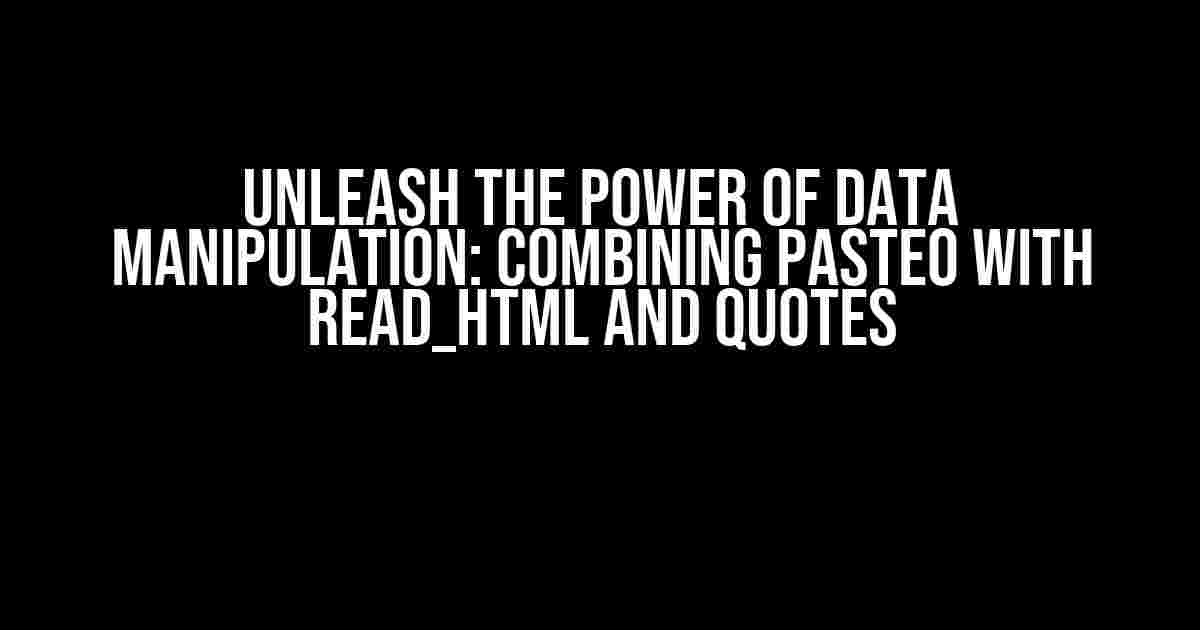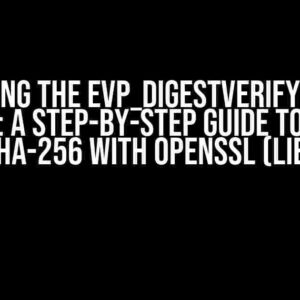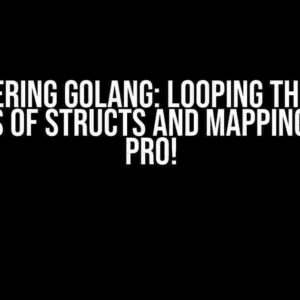In the world of data manipulation, having the right tools and techniques can make all the difference. In this article, we’ll dive into the powerful combination of paste0, read_html, and quotes in R, and explore how you can harness their capabilities to tame even the most unruly datasets.
The Problem: Dealing with Messy Data
We’ve all been there – stuck with a dataset that’s riddled with inconsistencies, irregularities, and downright annoyances. Maybe it’s a web-scraped dataset with wonky formatting, or a CSV file with quotes in all the wrong places. Whatever the case, dealing with messy data can be a real pain.
But fear not, dear reader! With the trifecta of paste0, read_html, and quotes, you’ll be well-equipped to tackle even the most daunting data challenges.
Introducing paste0: The String Manipulation Powerhouse
paste0 is a fundamental R function that allows you to concatenate strings without adding spaces in between. Sounds simple, but trust us, it’s a game-changer. With paste0, you can:
- Combine multiple strings into a single string
- Remove unwanted characters or spaces
- Create custom string patterns and formats
# Basic usage of paste0
x <- "hello"
y <- "world"
paste0(x, y) # Output: "helloworld"read_html: The Web Scraping Workhorse
read_html is a powerful function from the rvest package that allows you to parse HTML documents and extract the data you need. With read_html, you can:
- Scrape data from websites with ease
- Extract specific HTML elements and attributes
- Handle complex web page structures with confidence
# Basic usage of read_html
library(rvest)
url <- "https://www.example.com"
html <- read_html(url)
html_nodes(html, "h1") # Extract all h1 tagsThe Mighty Quotes: Taming the Unruly
Quotes are an essential part of data manipulation, but they can also be a major pain. Whether it's dealing with escaped quotes, inconsistent quote usage, or pesky quote characters, quotes can quickly become a thorn in your side.
Luckily, with R's built-in quote handling capabilities, you can easily:
- Escape quotes and other special characters
- Handle quoted strings and patterns
- Use quotes to delimit and separate data
# Basic usage of quotes
x <- "hello \"world\""
cat(x) # Output: "hello "world""Combining the Trifecta: A Powerful Data Manipulation Workflow
Now that we've introduced each component of our trifecta, let's see how we can combine them to tackle a real-world data manipulation challenge.
Suppose we have a web page with a table that contains information about various countries, including their names, capitals, and populations. Our goal is to extract this data and create a clean, usable dataset.
# Load the necessary libraries
library(rvest)
library(stringr)
# Define the URL and parse the HTML
url <- "https://example.com/countries"
html <- read_html(url)
# Extract the table elements
tables <- html_nodes(html, "table")
# Extract the table rows
rows <- html_nodes(tables, "tr")
# Initialize an empty dataframe
df <- data.frame()
# Loop through each row and extract the data
for(i in 1:length(rows)){
row <- rows[i]
cols <- html_nodes(row, "td")
country <- html_text(cols[1])
capital <- html_text(cols[2])
population <- html_text(cols[3])
# Combine the data using paste0 and quotes
data <- paste0('"', country, "\", \"", capital, "\", \"", population, "\"")
# Add the data to the dataframe
df <- rbind(df, data.frame(country, capital, population))
}
# View the resulting dataframe
head(df)Tips and Tricks: Taking Your Data Manipulation to the Next Level
With the trifecta of paste0, read_html, and quotes, you're already well-equipped to tackle most data manipulation challenges. However, here are some additional tips and tricks to take your skills to the next level:
-
Use regular expressions to extract specific patterns from your data.
library(stringr) x <- "hello world" str_extract(x, "\\w+") # Extract words -
Leverage the power of R's vectorization to perform operations on entire datasets at once.
x <- c("hello", "world") paste0(x, "!") # Output: c("hello!", "world!") -
Experiment with different quote types and escapes to handle complex string patterns.
x <- "hello \"world\"" cat(x) # Output: "hello \"world\"" -
Don't be afraid to get creative with your string manipulation techniques - the possibilities are endless!
x <- "hello world" paste0(strtoupper(x), "!!") # Output: "HELLO WORLD!!"
Conclusion: Unleashing the Power of Data Manipulation
In this article, we've explored the incredible combination of paste0, read_html, and quotes in R, and how they can be used to tackle even the most challenging data manipulation tasks. By mastering these tools and techniques, you'll be well-equipped to handle anything that comes your way.
So go forth, dear reader, and unleash the power of data manipulation upon your datasets! With the trifecta of paste0, read_html, and quotes, you'll be unstoppable.
| Function | Description |
|---|---|
| paste0 | Concatenates strings without adding spaces |
| read_html | Parses HTML documents and extracts data |
| Quotes | Handles quotes and special characters in strings |
Frequently Asked Question
Get ready to uncover the secrets of combining paste0 with read_html and quotes in R programming!
Q1: What is the purpose of using paste0 in read_html?
The paste0 function is used in read_html to concatenate strings together to form a single URL or HTML string. This is particularly useful when you need to build a URL dynamically by combining different parts of the URL.
Q2: How do I handle quotes in read_html when using paste0?
When using paste0 with read_html, you need to be mindful of quotes. You can escape quotes by using a backslash (\) before the quote. For example, if you want to include a double quote in your string, you would use \" like this: paste0("https://example.com?page=", 1, "\"")
Q3: Can I use paste0 with read_html to read data from a local HTML file?
Yes, you can use paste0 with read_html to read data from a local HTML file. Simply use paste0 to construct the file path and filename, and then pass it to read_html. For example: read_html(paste0("file:///", getwd(), "/data.html"))
Q4: How do I troubleshoot issues with paste0 and read_html?
When troubleshooting issues with paste0 and read_html, check the constructed URL or HTML string to ensure it's correct and valid. You can do this by printing the output of paste0 and verifying it manually. Also, check the error messages returned by read_html to identify any syntax errors or issues with the HTML content.
Q5: Are there any performance considerations when using paste0 with read_html?
Yes, there can be performance considerations when using paste0 with read_html, especially when dealing with large HTML files or slow network connections. To improve performance, consider using caching mechanisms or parallel processing to speed up the data retrieval process.



